The women’s football tournament at the 2020 Olympic Games has grabbed our attention over the last week and has included shock scorelines, such as the USA’s 3-0 loss to Sweden, and incredible feats, including the Netherlands’ 21 goals in their three group games. However, there was still plenty to sort out in the final round of group stage matches, particularly in Group E. Team GB had already sealed their place in the quarter-finals after victories against Chile and Japan, whilst Canada needed a win to guarantee top spot in the group at their opponents’ expense.
This tactical analysis will pick out the tactics that Canada employed throughout the game, as well as how they adapted to different situations. The analysis will also ask why Team GB struggled to break them down, including a look at the errors that prevented them building momentum for much of the first half.
Lineups

Canada head coach Bev Priestman, formerly Phil Neville’s England assistant coach, made seven changes from the team that defeated Chile in the second round. Stephanie Labbe came back into goal, with NY/NJ Gotham’s Kailen Sheridan featuring against Chile in her place, whilst Shelina Zadorsky, Jessie Fleming, Julia Grosso and Nichelle Prince also moved to the bench. Desiree Scott and all-time top scorer Christine Sinclair were rested for this game, with Canada switching to a 4-2-3-1 setup instead. Centre-back Vanessa Gilles, midfielder Sophie Schmidt and forwards Deanne Rose, Adriana Leon and Evelyne Viens all came into the starting XI.
Team GB, meanwhile, made five changes of their own, with head coach Hege Riise having planned a team before the tournament for each group game. Out went England captain Steph Houghton, midfielder Kiera Walsh, winger Lauren Hemp and striker Ellen White, all of Manchester City Women, whilst Arsenal Women captain Kim Little also made way. Into the team came Chelsea Women’s Millie Bright, Manchester City trio Caroline Weir, Jill Scott and Georgia Stanway and Houston Dash’s Rachel Daly, whilst Nikita Parris moved from a wing position to a central attacking role, as England moved from a 4-4-1-1 to a 4-4-2.
Team GB’s attack
Team GB only required a draw to seal top spot in the group, and that influenced their approach to this game. It was noticeable that they sat back much more than they had done in the last two games, trying to protect their goal, with Canada having plenty of possession as a result. However, when they did look to attack, GB couldn’t create many clear-cut opportunities.
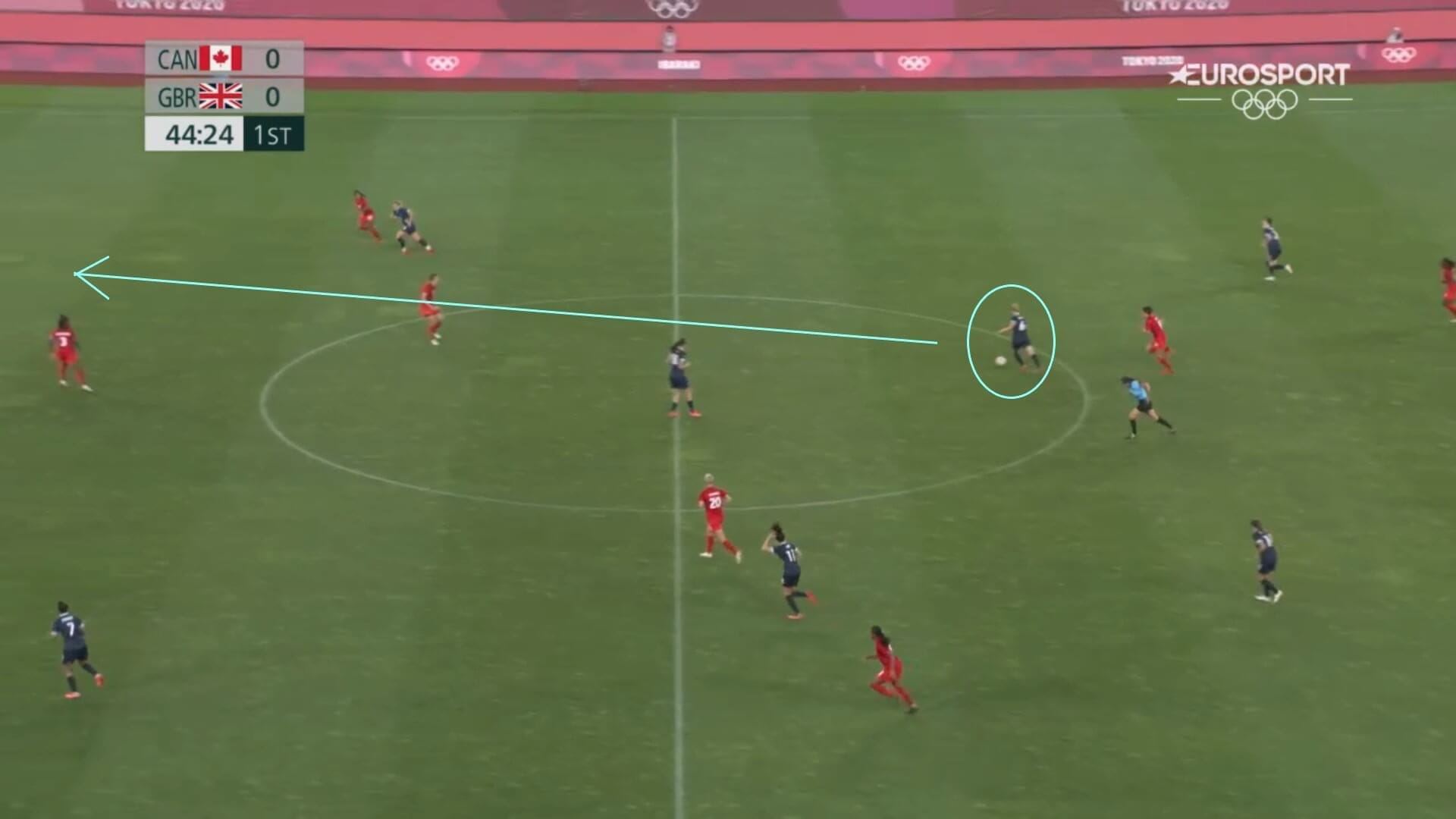
This mostly came down to their lack of quality on the ball, predominantly when passing it. Here, Chelsea midfielder and Wales captain Sophie Ingle is transferring the ball into the attacking half, but overhits her pass and allows Canada to easily sweep up at the back. This happened a few times, with GB not having their usually excellent timing or confidence with the ball, and loose passes and poor touches were a common feature of the first half. When finding the reasons for GB’s struggles in attack, this was unquestionably a factor.
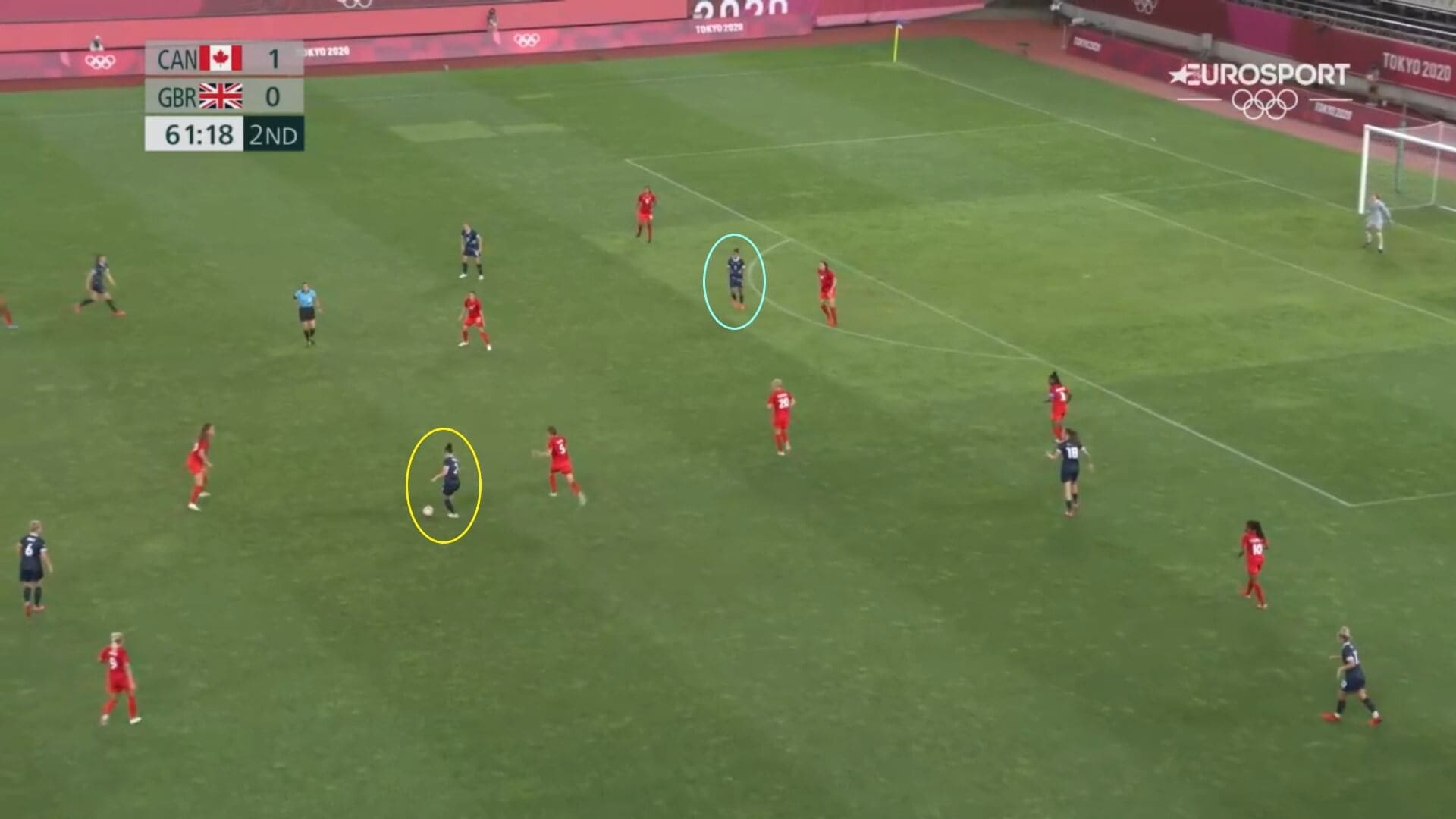
However, the other problem came through their setup. Nikita Parris seemed unable to make things happen for her team, and the decision to partner the new Arsenal striker with Jill Scott was strange, as Scott is more of a defensive, box-to-box player. Therefore, whilst both tried to press Canada at the back, neither seemed comfortable doing it, and that was key in GB’s inability to break their opponents down.
This image demonstrates another issue with those two playing in attack. Parris doesn’t tend to make runs behind defenders in the same way that Ellen White does, and instead drifts towards the ball more, as we saw her do on occasion for Lyon Feminin last season. This makes it harder for her teammates to play forwards, with right-back Lucy Bronze, in the yellow circle here, losing momentum due to no forward passing option being available.
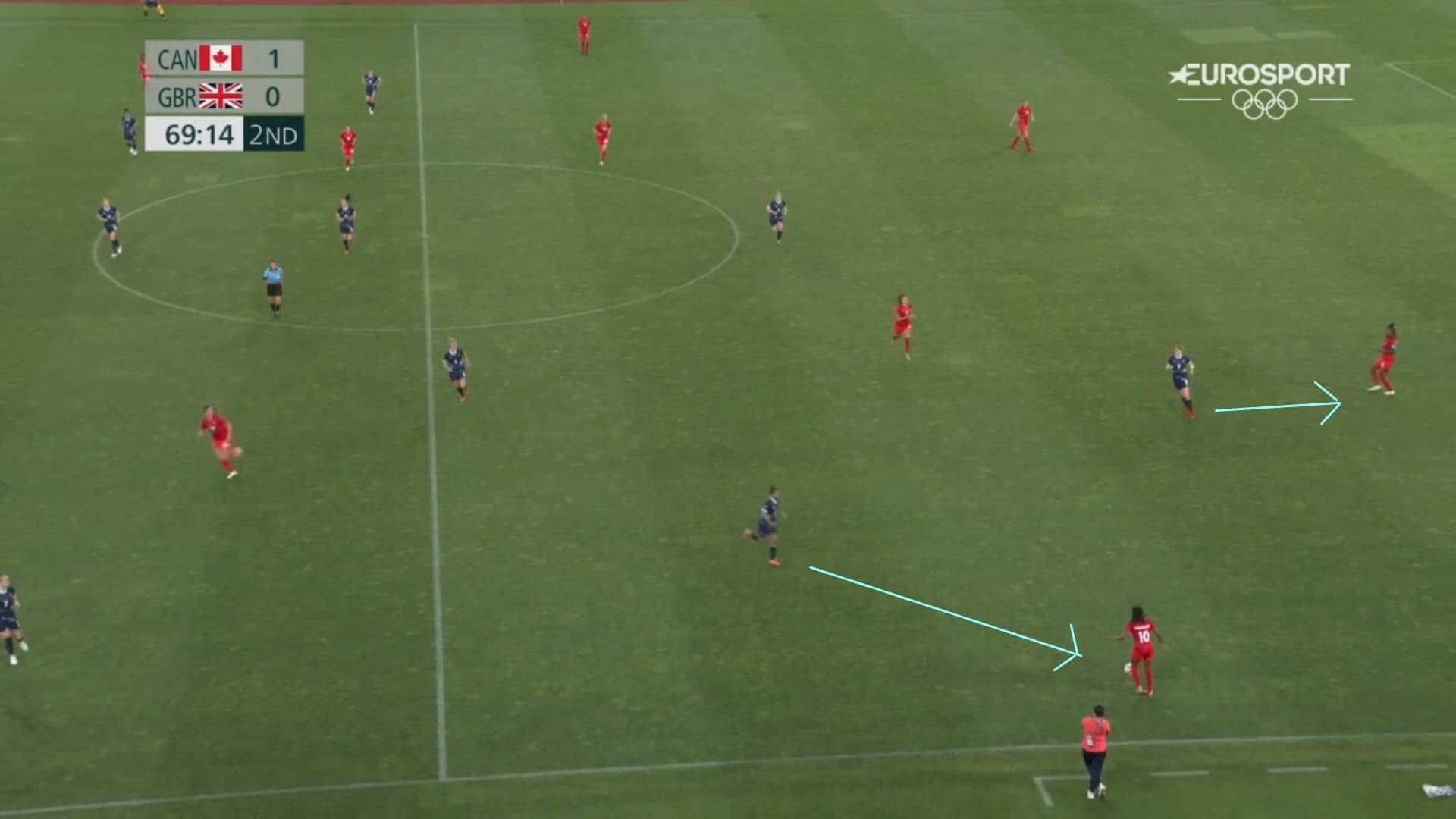
It wasn’t long after this that Hege Riise made changes, bringing on White and Kim Little for Scott and Rachel Daly (a move which saw Parris go back to the wing). As both replacements are naturally attack-minded players, this gave Team GB an increased threat in the final third, and, as this image shows, they pressed Canada with a higher intensity. Canada’s defenders up to this point had had time to look around and make decisions when in possession, but they now had to move it quicker, increasing the likelihood of them making a mistake. This was what GB had been missing, and it was a big factor in their second-half revival.

The attacking changes kept coming for GB, with Hege Riise clearly seeing a goal coming for her side. Chelsea star Fran Kirby, who had missed the first two group games with an injury, came on and formed a front three with White and Parris, giving Team GB more options in the final third and therefore a better chance of scoring.
If we compare this image to the previous one with Parris and Scott in front of the defence, we can see the huge improvement in their attacking performance, and how the substitutes added what had been missing beforehand. There was still some hesitation when advancing forwards, with Caroline Weir slowing the ball down here and allowing Canada to get back behind it, but the fact that there were runners made a big difference to GB’s attack in the second half.
Kim Little
If there is a question about which Team GB player had the biggest impact on the game, then the answer is Scotland’s Kim Little.
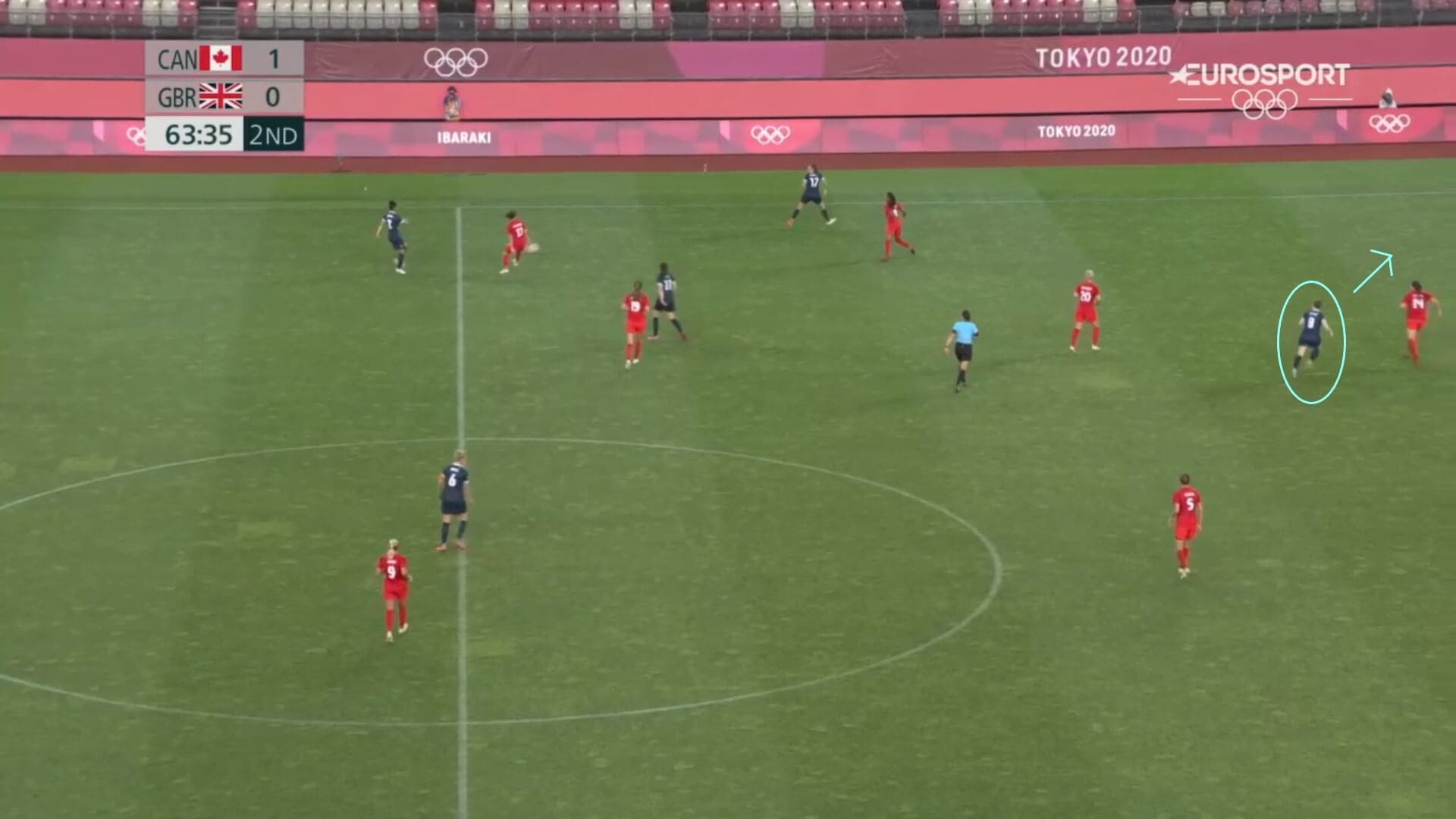
Playing a defensive game is all well and good, but the team doing it needs to have good ball control when they do win possession, and Team GB lacked that, as has already been shown. Therefore, the tactical switch was needed, with Kim Little giving them more freedom in attack, and they created more opportunities after her arrival. Her energy meant she could find spaces that GB had previously not been using, again making Canada think and work harder.
The ball is being passed forwards around the halfway line here, but, whilst two GB players have offered shorter passing options, Little has angled her run away from it, opening up the pitch and stopping Canada from crowding around the ball, as that would leave her in open space behind them. Her spatial awareness helped GB to dominate the closing stages, and was a major reason for their equalising goal as the game was coming to a close.
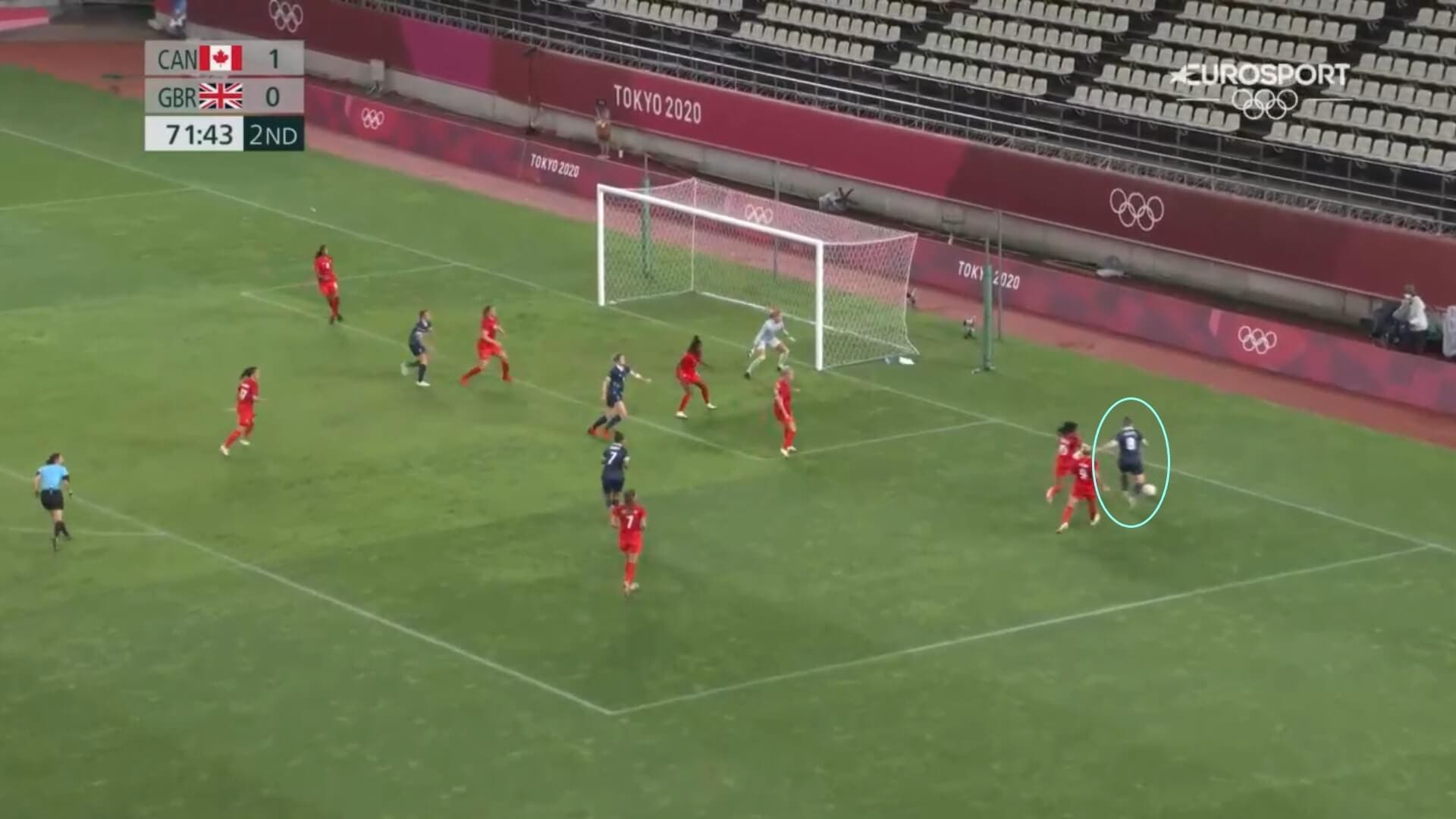
This image demonstrates a similar point, with Little getting behind the Canadian defence and creating opportunities for her teammates. The Arsenal midfielder is not a prolific scorer, but she has good ball control and finds gaps between opponents around the pitch, which is why she is such a dangerous player. Here, she has run towards the goal line, trying to pull the ball back for a teammate in the middle. As a result of her movement, more GB players have got into the box, forcing Canada to close the ball down and mark those attackers at the same time, leading to more gaps being available for GB to exploit.
Therefore, Little had a huge impact on the game and was a big part of GB’s switch in focus from defence to attack in the second half.
Canada’s changing tactics
It was clear from the early stages of the game that Canada wanted to limit Team GB’s options, thereby controlling the game even when out of possession.
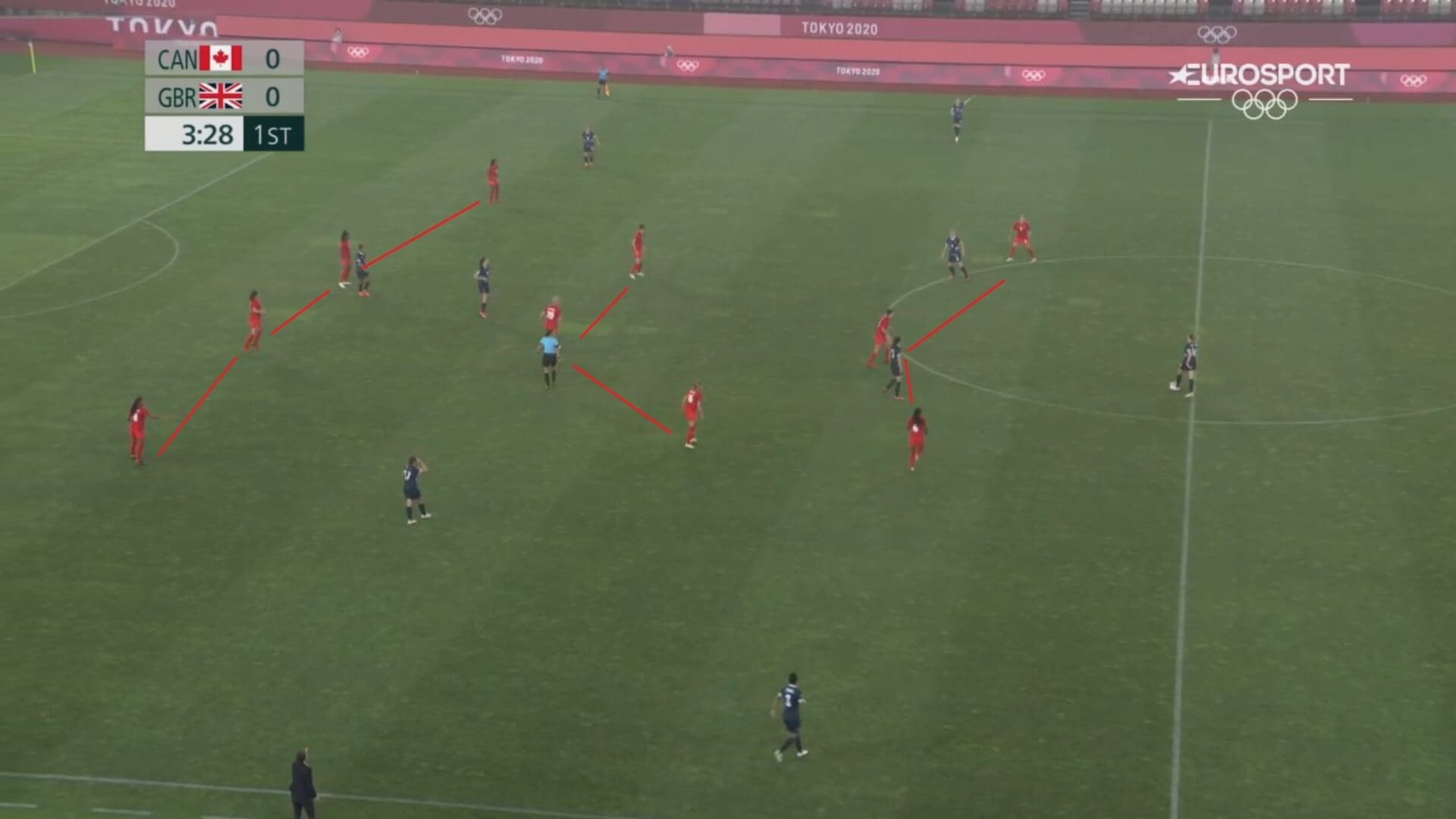
Canada always have a flexible structure during matches, starting this one in a 4-2-3-1, but drifting into a 4-4-2 or a 4-3-3 as games go on. This image shows them in the second of those formations, with all three ranks positioned narrowly as Canada looked to dominate the midfield areas. This forced GB to play around them, using the full-backs to feed balls into the box.
The reason Canada left the wide channels open is because it is easier to defend against teams who attack down the wings, so Canada’s pre-game planning was obvious, with them working out how they could dictate GB’s passing around the pitch, allowing them to get in the right positions early to either close the ball down or block spaces off.
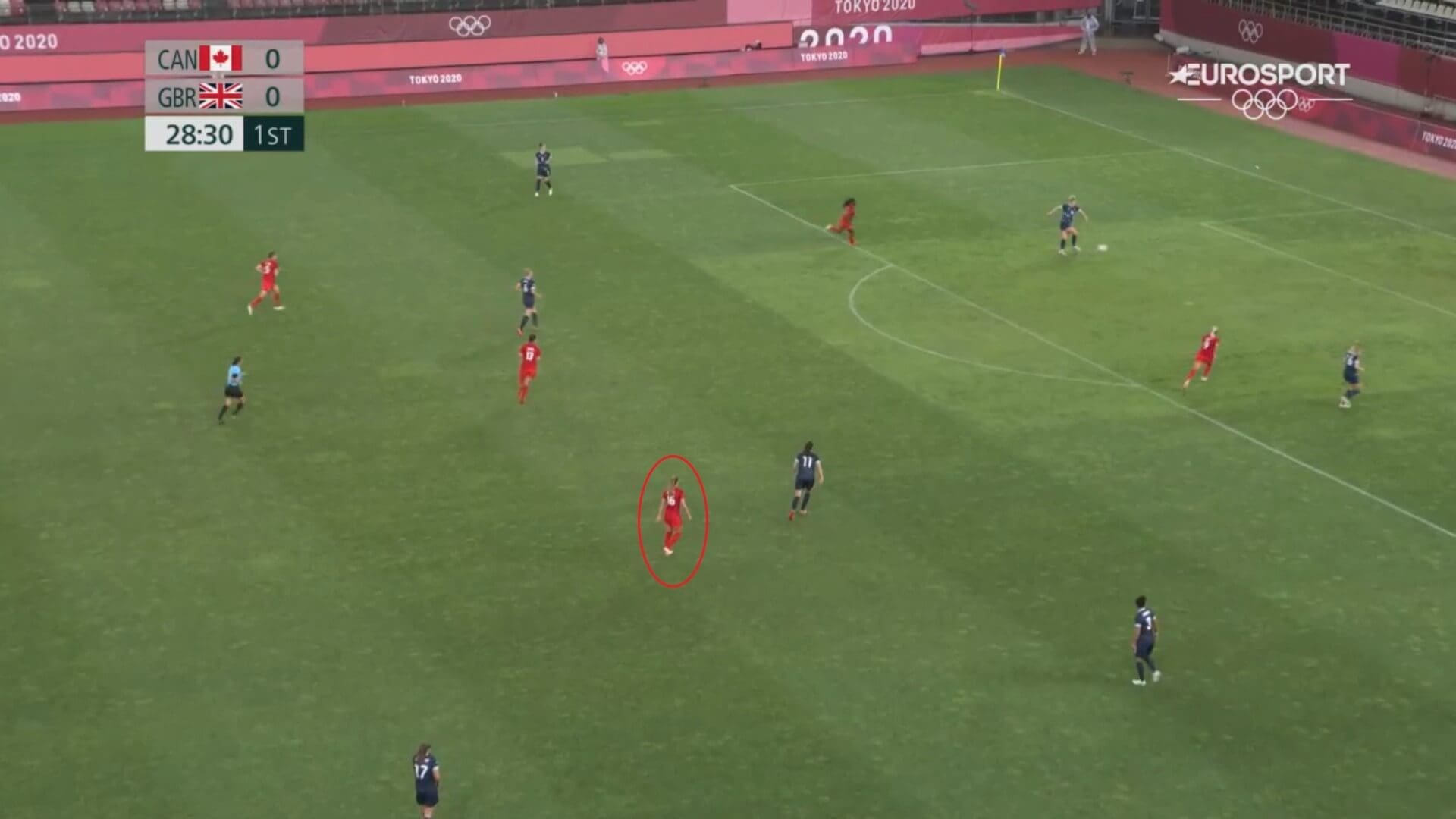
The role of Janine Beckie was particularly important in this. The Manchester City player tends to operate as a right-winger or, occasionally, a right-back. However, she played more centrally in this game, with Bev Priestman using her pace to nullify the threat and influence of her clubmate Caroline Weir, especially as the Scotland international was in a deeper role during this match. Weir has an excellent passing range and can pick out different players around the pitch, so Canada wanted to ensure she didn’t pose a threat, with Beckie’s free role between the midfield and forward lines allowing her to get tight to any GB players trying to influence the game.
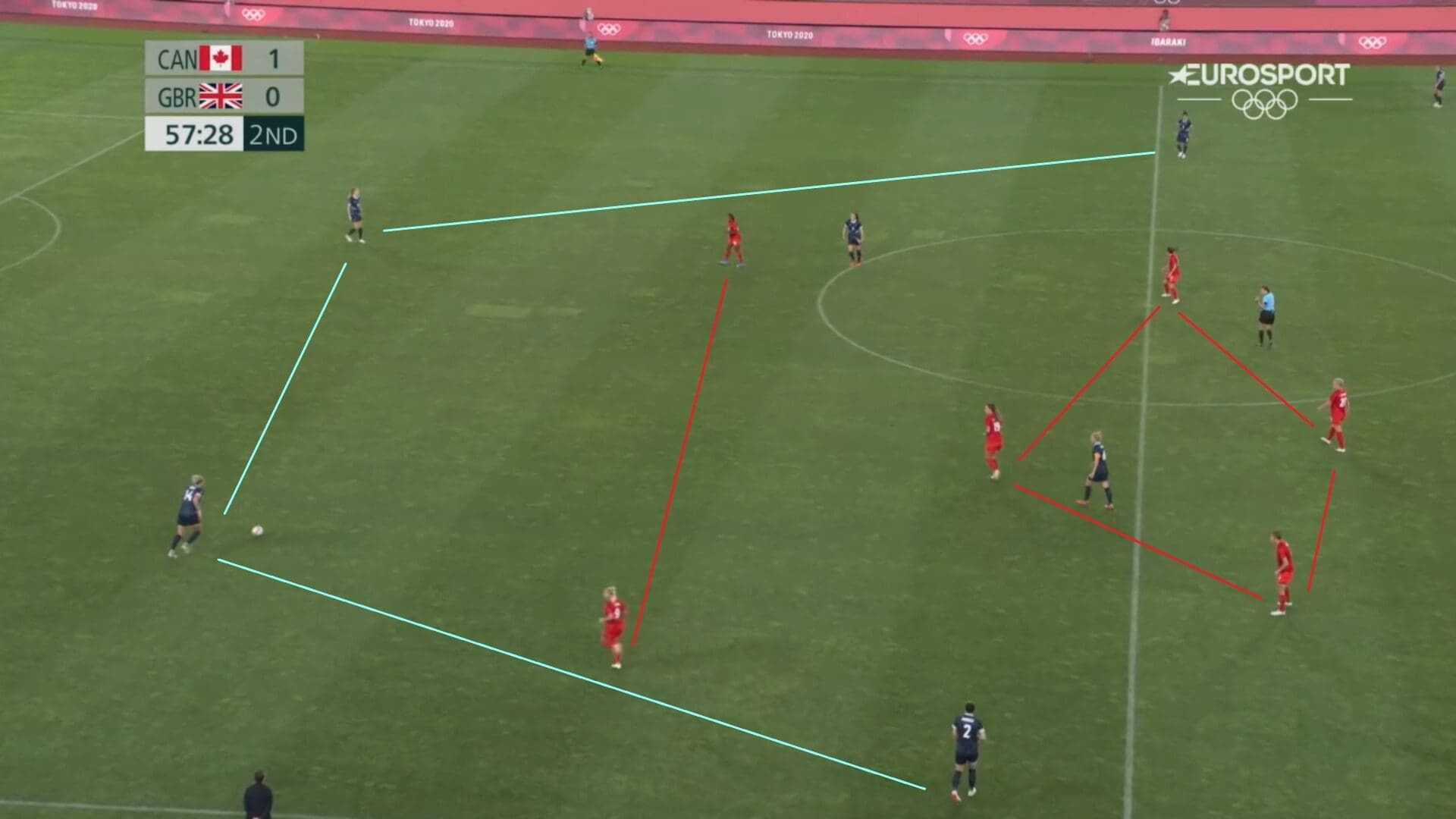
However, Beckie is not naturally a central player, as mentioned, and Canada wanted to improve their balance in the second half. As a result, Chelsea’s Jessie Fleming and PSG Feminines’ young star Jordyn Huitema were introduced at half-time for Beckie and Deanne Rose, with Fleming playing alongside Quinn and Sophie Schmidt in the midfield, whilst Huitema dropped between the midfield and attack, just as Beckie had done. Huitema is more flexible in terms of positioning, as she can operate in the central channel as well as on either wing, so gave Canada more options in attack in the second half. Here, she has formed a diamond in the midfield, whilst another substitute, Nichelle Prince, has partnered West Ham United Women forward Adriana Leon in a front two.
Team GB pushed their full-backs even higher in the second half, but Canada’s continual pressing of centre-backs Millie Bright and Arsenal’s Leah Williamson meant that they still had little time on the ball, and that was another reason for the Canadians’ control for the majority of the game.
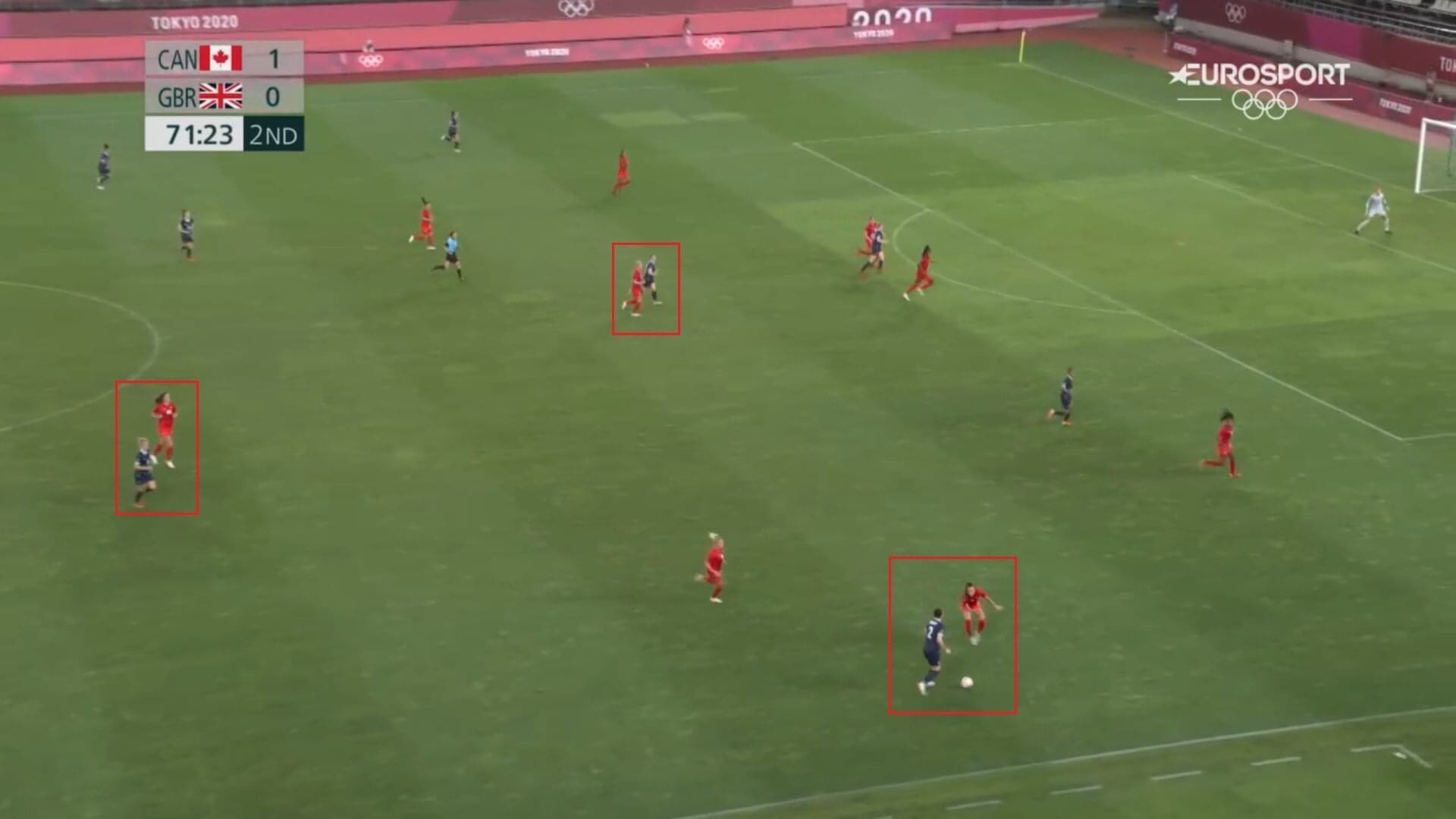
The other thing that came from Canada’s alterations was added pace. Here, they have closed several Team GB players down, limiting their options. The midfielders have come back to help with this, increasing their numbers and allowing them to maintain their defensive line at the same time. This was likely in response to the threat posed by Kim Little getting behind them more, as we saw how she was drawing the Canadian defence out and creating gaps in the box with her forward runs. Therefore, this again demonstrates how Canada’s changing tactics were a crucial part of their performance.
Conclusion
In conclusion, this analysis has looked at the women’s Olympic football match between Canada and Team GB during the final round of group stage fixtures. We have focused on the reasons why GB struggled to get into the game offensively, and how Canada continually altered their playing style to keep their opponents at bay for as long as possible. In fact, had GB not got a lucky deflection off substitute Nichelle Prince, it is possible that they may not have found the net at all.
However, we need to remember that this was not GB’s first-choice XI, and their second-half improvements meant they deserved their equaliser when it came. Hege Riise said afterwards that GB showed their “powers of recovery” to come back from a goal down, and their desire in the closing stages certainly highlighted that.
Team GB have been given a tricky draw against Australia in the quarter-finals, whilst Canada face another strong team, Brazil, with both ties taking place on Friday. However, both sides will need to step up in order to progress to the semi-final stage of the competition.





Comments